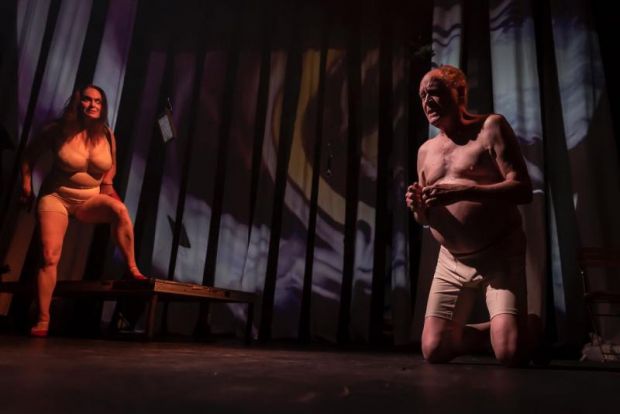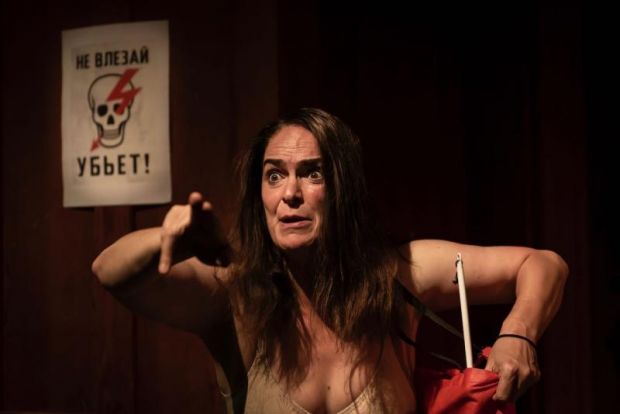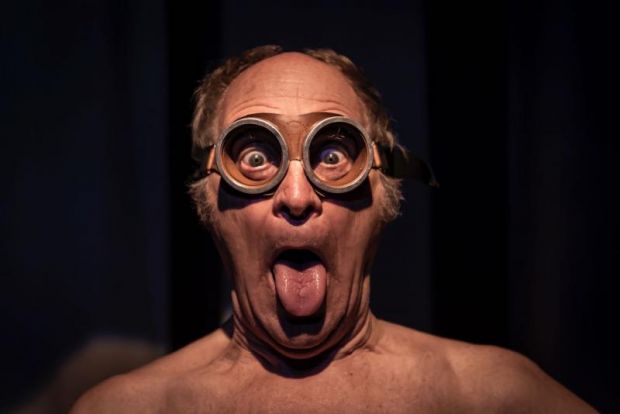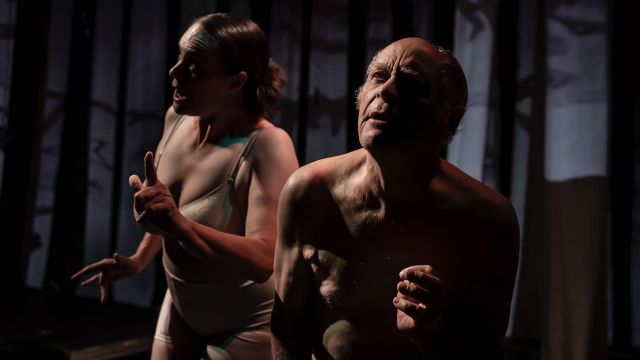Katyn
Katyn, says writer-director-performer Jim Daly, ‘proceeds from a response born in shock at the meaningless grotesque of the Katyn massacre’. What he has made of his response is a play that is often opaque yet astonishing in its intensity, its physicality and its rage.
The name of the place ‘Katyn’, near Smolensk, has become shorthand for the massacre of close to 22,000 Poles in 1940 on the orders of Stalin – 8000 Army officers, 6000 police and 8000 ‘intelligentsia’ – landowners, factory owners, ‘saboteurs’, gendarmes, lawyers, officials, intellectuals and priests – buried in a series of mass graves (one in the Katyn Forest). Culpability has been subject to claim and counter claim, propaganda and counter propaganda, denial, the suppression of evidence and the politics of WWII and the Cold War that followed. In 1943, the Nazis accused the Soviets. The Soviets accused the Nazis – and on it went.

The play begins outside the theatre. Mr Daly, as a bus driver, gathers the audience for a long ride – into the past and into the Katyn Forest. Once there, the amazing Carolyn Bock (in nothing but form-fitting underwear and some red shoes) welcomes us and asks about our journey. She’s soon joined by Mr Daly, who strips off to his underwear and… away we go. Peter Mumford’s design is a representation or an impression of the forest – and various threatening images by Tatiana Doroshenko are projected through the ‘trees’ onto a floor to ceiling cyclorama.
Ms Bock and Mr Daly enact a response to the horrific events, rather than the events themselves, by representing, rather than becoming, various key characters in the story. We know this is so only because these characters are listed in the program – characters such as ‘Stalina’, Pilot Lieutenant Janina Lewandowska and Major Zbyszek Kowalewicz (Ms Bock), and ‘Kombrig’ Zarubin (chief NKVD interrogator), the infamous Lavrentiy Beria and Wanda Wasilewska (Mr Daly). But these two highly skilled actors evoke these characters into a kind of grotesque (metaphoric, allusive?) life by the most idiosyncratic means – bizarre facial expressions, postures and movements, garbled voices, minimal costume changes (the underwear does not change) and direct address to the audience. For most of the show’s eighty minutes, we may be fascinated by the disciplined physicality, but we are also wearied by the struggle to interpret or to make sense of what we are seeing – and grateful when either actor speaks directly and clearly. We are often hard pressed to distinguish who is who and just why we are meeting them. Perhaps a detailed knowledge of the Katyn saga might help, but even then, I am not so sure.

Bertolt Brecht kept a small toy donkey on his desk. He hung a sign around its neck reading, ‘Even I must understand.’ I was reminded of that during this helter-skelter show when Ms Bock steps out of whomever of the several characters she plays and addresses the audience directly: ‘Sometimes we forget about you.’ Indeed. I’m not sure if that ‘sometimes’ covers this entire show or just that particular passage of it, but Jim Daly, as far as I can tell, seems not too interested in having us understand the story let alone engage with it. What response does he want? I’m in no doubt that he and Carolyn Bock know what they are doing, and they know what they are doing means, such is the mesmerising energy and committed precision of their movements and their voices, but we are left – mostly – dazed and confused.
Katyn is part of Mr Daly’s PhD research – Performing the Grotesque from Hybridity and Excess: An Investigation Sited in the Katyn Massacre. That points to Mr Daly’s intentions, but it is not a great help to an audience witnessing the play. An academic pursuit has become an exclusionary experiment. We can’t call this ‘self-indulgent’ because of the seriousness of the endeavour and the amount of thought and energy invested in it. My problem and that of most of the audience, is simply a matter of communication. Is this show about Katyn or ‘the grotesque’? Is the massacre grotesque? Was it ‘meaningless? In Mr Daly’s program notes, it is clear that the chosen performance mode is absolutely deliberate. He writes, ‘While the grotesque is often baffling [!] and uncomfortably humorous, it sometimes includes a pronounced feeling of animality, invasion and of the presence of a nameless thing at work – an “It”. My research aims to know and describe these and other things from the inside, phenomenologically.’ As such, this approach could be an investigation that evolves into clarity, or it could be a creator disappearing up his own academic fundament. For the time being, I shall lean toward the former and applaud the sheer effrontery of the presentation.
Michael Brindley

Photographer: Darren Gill
Subscribe to our E-Newsletter, buy our latest print edition or find a Performing Arts book at Book Nook.

